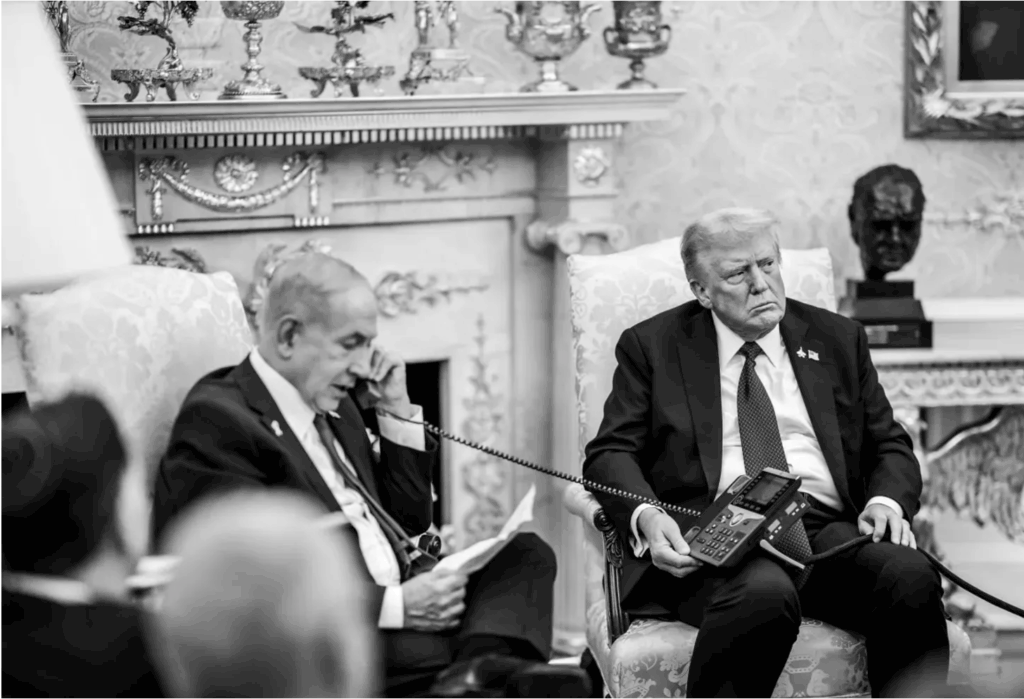Every picture tells a story

Normally this spot is reserved for photographs I’ve taken. But I thought I’d make an exception for this remarkable snap taken by a White House photographer. It shows Trump holding the telephone into which Netanyahu is reading the apology demanded by Trump to the Emir of Qatar for the Israeli strike on 9 September of Doha where ceasefire negotiations with Hamas were taking place.
Look at the expression on Trump’s face. The photograph evokes images of an angry parent forcing an errant teenager to make a phone call apologising to his school’s headmaster for shitting in his armchair.
It comes from Andrew Sullivan’s blog in which he explains the context:
The critical thing that happened — the thing that changed the entire dynamic — is that Netanyahu finally got so cocky last month he decided to bomb Qatar. Israel bombs other countries all the time at will, of course, but the concept of actually bombing Hamas diplomats while in negotiation must have been particularly irresistible: the mother of all fuck-yous to international law.
The only trouble was that this time, Bibi had bombed Trump’s Qatari sugar-daddies — the ones who’d just bribed the fathomlessly corrupt president with a giant 747 and were busy funneling billions into Jared’s bank account. Worse than that: Bibi hadn’t even bothered to tell the US in advance. So Trump was totally blindsided and humiliated.
Think about that for a moment: the prime minister of a foreign country believed he could bomb diplomats of a US ally and military base without telling the US in advance and get away with it. This staggering Israel exception to every rule is so routine we barely even notice it anymore. But in this case, the bombing made Trump seem less powerful than Netanyahu.
Big mistake when dealing with a narcissist.
Quote of the Day
”The biggest problem is not to let people accept new ideas, but to let them forget the old ones.”
- John Maynard Keynes
Musical alternative to the morning’s radio news
Joseph Bologne | Symphonie Concertante in G major – Allegro
New to me — and exhilarating.
Long Read of the Day
Is the AI bubble history repeating itself? Ask a chatbot
My latest Observer column
In 1954, while working on The Affluent Society, the economist John Kenneth Galbraith paused to compose an elegant little history of the days preceding the crash that triggered the Great Depression. The resulting book, The Great Crash 1929, came out in 1955 and sold like hot cakes. “I never enjoyed writing a book more,” Galbraith recalled afterwards, and readers could confirm that as they made their enjoyable way towards his sardonic conclusion: that the common denominator of all speculative bubbles is the belief of participants that they can become rich without doing much (or indeed any) work.
Revised editions of the book, each time with updated research and a more timely version of the introduction written by Galbraith, were published in 1961, 1972, 1988, 1997 and 2009. (It remains in print today as a Penguin Modern Classic.) At one point, someone asked him what was the point of continually looking back to what was becoming ancient history. He replied that it was the task of the historian “to keep fresh the memory of such crashes, the fading of which correlates with their reoccurrence”.
In that spirit, let us consider the AI bubble inflating around us – and the crash that will follow when it bursts…
My commonplace booklet
How Hunter S. Thompson learned to write
But there was a different Hunter, unseen by the public, and this alter ego was disciplined and ruthlessly organized—a veritable Clark Kent of the journalism trade, hidden behind a more flamboyant Gonzo Superman.
This hidden Hunter refined his writing chops by typing out The Great Gatsby and A Farewell to Arms. “Your hands don’t want to do their words—but you’re learning,” he later explained.
When friends laughed at this technique, he defended it in almost mystical terms: “I just want to feel what it feels like to write that well.” Along the way, he was internalizing the texts as he recreated them, page after page. In the aftermath, Hunter S. Thompson gradually emerged as a true heir to Hemingway and Fitzgerald, taking his place as one of the great American prose stylists of the century.
No MFA program or writing teacher would ever ask students to do this rote typing. Not because it doesn’t work—I suspect that it does—but simply because who has the patience to learn in such a painstaking, arduous way?
Hunter Thompson did.
From Ted Gioia’s excellent 3-part essay on the rise and fall of Thompson.
This Blog is also available as an email three days a week. If you think that might suit you better, why not subscribe? One email on Mondays, Wednesdays and Fridays delivered to your inbox at 5am UK time. It’s free, and you can always unsubscribe if you conclude your inbox is full enough already!
